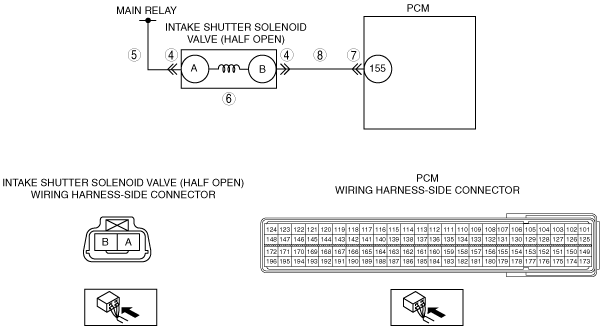|
1
|
VERIFY FREEZE FRAME DATA HAS BEEN RECORDED
• Has FREEZE FRAME DATA been recorded?
|
Yes
|
Go to the next step.
|
|
No
|
Record the FREEZE FRAME DATA on the repair order, then go to the next step.
|
|
2
|
VERIFY RELATED REPAIR INFORMATION AVAILABILITY
• Verify related service repair information availability.
• Is any related repair information available?
|
Yes
|
Perform repair or diagnosis according to the available repair information.
• If the vehicle is not repaired, go to the next step.
|
|
No
|
Go to the next step.
|
|
3
|
VERIFY CURRENT SIGNAL STATUS: IS CONCERN INTERMITTENT OR CONSTANT?
• Connect the M-MDS to the DLC-2.
• Clear the DTC from the PCM memory using the M-MDS.
• Run the vehicle under the FREEZE FRAME DATA stored condition.
• Is the same DTC present?
|
Yes
|
Go to the next step.
|
|
No
|
Intermittent concern exists.
Perform the “INTERMITTENT CONCERNS TROUBLESHOOTING”.
|
|
4
|
INSPECT INTAKE SHUTTER SOLENOID VALVE (HALF OPEN) CONNECTOR FOR POOR CONNECTION
• Turn the engine switch off.
• Disconnect the intake shutter solenoid valve (half open) connector.
• Inspect for poor connection (such as damaged/pulled-out pins, and corrosion).
• Is there any malfunction?
|
Yes
|
Repair or replace the terminal, then go to Step 9.
|
|
No
|
Go to the next step.
|
|
5
|
INSPECT INTAKE SHUTTER SOLENOID VALVE (HALF OPEN) CONTROL CIRCUIT FOR OPEN CIRCUIT
• Turn the engine switch to the ON position (Engine off).
• Measure the voltage between Intake shutter solenoid valve (half open) terminal A (wiring harness-side) and body ground
• Is the voltage B+?
|
Yes
|
Go to the next step.
|
|
No
|
Repair or replace the wiring harness for a possible open circuit, then go to Step 9.
|
|
6
|
INSPECT INTAKE SHUTTER SOLENOID VALVE (HALF OPEN)
• Inspect the intake shutter solenoid valve (half open).
• Is there any malfunction?
|
Yes
|
Replace the intake shutter solenoid valve (half open), then go to Step 9.
|
|
No
|
Go to the next step.
|
|
7
|
INSPECT PCM CONNECTOR FOR POOR CONNECTION
• Turn the engine switch off.
• Disconnect the PCM connector.
• Inspect for poor connection (such as damaged/pulled-out pins, and corrosion).
• Is there any malfunction?
|
Yes
|
Repair or replace the terminal, then go to Step 9.
|
|
No
|
Go to the next step.
|
|
8
|
INSPECT INTAKE SHUTTER SOLENOID VALVE (HALF OPEN) CONTROL CIRCUIT FOR OPEN CIRCUIT
• Turn the engine switch off.
• Inspect for continuity between intake shutter solenoid valve (half open) terminal B (wiring harness-side) and PCM terminal 155 (wiring harness-side)
• Is there continuity?
|
Yes
|
Go to the next step.
|
|
No
|
Repair or replace the wiring harness for a possible open circuit, then go to the next step.
|
|
9
|
VERIFY TROUBLESHOOTING OF DTC P0663 COMPLETED
• Turn the engine switch off.
• Make sure to reconnect all disconnected connectors.
• Turn the engine switch to the ON position (Engine off).
• Clear the DTC from the memory using the M-MDS.
• Run the vehicle under the FREEZE FRAME DATA stored condition.
• Is the same DTC present?
|
Yes
|
Replace the PCM, then go to the next step.
|
|
No
|
Go to the next step.
|
|
10
|
VERIFY AFTER REPAIR PROCEDURE
• Perform the “After Repair Procedure“.
• Are any DTCs present?
|
Yes
|
Go to the applicable DTC troubleshooting.
|
|
No
|
Troubleshooting completed.
|
